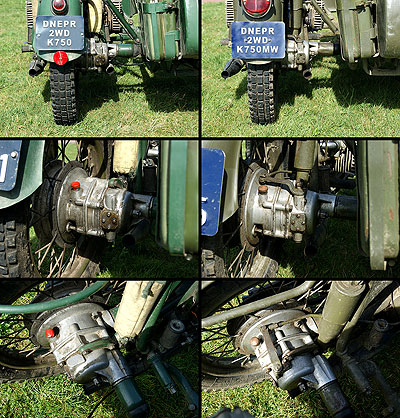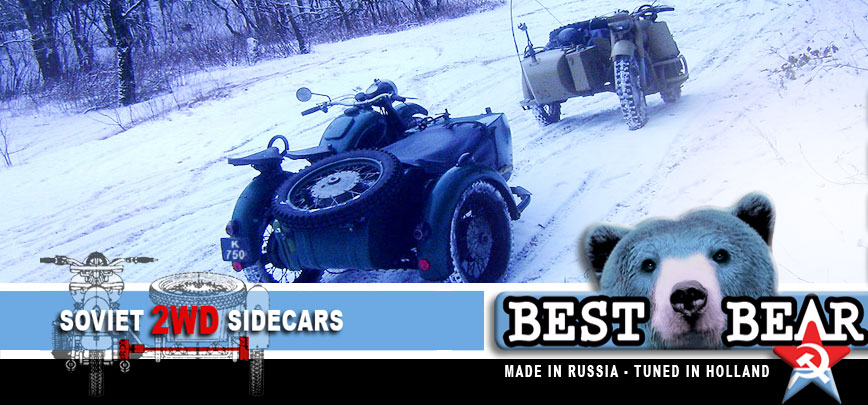|
Driven
sidecar motorcycles of the Soviet-Russian Armed Forces
The flathead (side-valve) engines
The engines usually mounted in our machines
are of the flathead type, dating back to the original German
BMW R71 design of the late 1930’s. Initially these were
built as a license - part of the Molotov-Ribbentrob pact -
under the model name M-72 (Mototsikletnyi 72) since 1940 in
Moscow and Leningrad. After the German invasion production
was relocated in Charkow, Gorky (GAZ) and finally, safely
out of reach for German bomb-attacks, in Irbit - now the Ural
factory. During war time production figures reached to around
15.000 units, under almost unworkable conditions at the start.
The sidecar bodies were made by GAZ at the Gorky plant until
the late 1940’s. From 1954 onwards the heavy M-72 sidecar
combination became available for private ownership. Production
of the M-72 by IMZ in Irbit ended in 1961, when it was replaced
by the 650 cc o.h.v. M-61 model, introduced in 1959.

The Gorky based production facilities
were relocated from the automobile factory GAZ to the Ukraïnian
capital Kiev by 1950, thus creating the KMZ factory which
became the sole supplier of the Soviet Army around 1955. M-72’s
produced from 1951 by KMZ (the Dnepr factory) were almost
identical to those made in Irbit, but in 1959 the model was
improved with a swing-arm rear suspension, new front forks
and mudguards as well as some minor alterations to the engine.
The new model name was K750, produced for both the army and
the civilian market. Late 1963 the K750 MW was introduced;
with its reverse gear, permanent sidecar drive and differential
lock this model was exclusively built for the armed forces,
under stringent military quality control.
The Dnepr K750MW, a Dnepr
K750 with differential device:

Both models stayed in production until 1977 when they were
succeeded by the Dnepr MT12, a slightly modernised version
built for the army, export and home market as well. In 1984
the production of the 750 cc flathead engines came to an end
when the MT12 was taken out of production.
Over the years this flathead engine has proved to be a very
sturdy and big-hearted one that could cope well with the hardships
of the crude “road” and climate conditions of
either Siberia or some foreign battlefield. The sidecar body
is an almost direct copy of the Steib military type, used
by the German forces during World War II.
The Soviet style production methods differed from those in
the West: raw materials went into the immense plant and out
came the finished product - not a single process was contracted
out. Everything - from design, foundry, rolling and forging
to final assembly - took place in the enormous factory. Only
tyres, carburettors, electrical components and bearings were
supplied by other (state owned) factories.
|
|
From 1958 the M72, as a derivate called Chang Yiang, has
also been produced in China until 2007(!) at several factories
in very large numbers, mainly for the army and other state-authorized
use.
With an uninterrupted production life of almost 70 years the
R71/M-72 is probably the longest produced motor vehicle in
history, a convincing proof of quality of the basic 750 flathead
engine of German design.

Although the entire production made in
Kiev for the Soviet Army was of fairly good quality, we found
some typical material flaws to iron out as well as a couple
of parts for which there are far better alternatives available
in West European quality.
Our upgrades include amongst others a better oilpump and recalibration
of the oil distribution, better air filtration, German made
piston rings, better exhaust valves and reworking of the inlet
and exhaust ports, static counter-balancing of pistons and
small-ends within less than 1 gramm tolerance and better (asbestos-free)
clutchplates. Ignition coil, bearings and oilseals are also
replaced by West European quality parts.
With these modifications BestBear upgraded
engines are very reliable and smoothly running, also due to
the fact that every single part is checked and if only doubtful
replaced before we put the engine together again in a well
equiped non-production workshop: one man builds one engine
at the time, not hastened by production targets. Quality of
workmanship is what counts. Quite the opposite of former Eastern-Block
production philosophy you might say…..

The over-head-valve (OHV) engines
If you prefer it is also possible to
equip a driven sidecar combination with the KMZ 650 cc over-head-valve
engine, a development dating from the late 1960’s and
also widely used by the Soviet Armed Forces.
Advantages of these engines are less weight, better fuel economy,
more power, less heating and 12 volt electrics. Our upgrades
however are limited to better pistons, rings and pins, counter-balancing,
bearings, camshaft, valve springs, oilseals, and clutchplates.
Developing about 34 bhp at 5400 rpm these OHV engines are
higher revving and will give more cruising speed on a surfaced
road. However they certainly lack the rugged laid-back charm
of the 30 years older 750 cc side-valve engine design with
its pre-war character and manual advance-retard mechanism.

The Soviet Army machines
Due to the fact that these machines are
at least 25 and sometimes over 50 years old, we can not deliver
them from the shelf. Especially the versions built for the
Soviet Army are in high demand nowadays and not so easy to
come by. This is because their much better quality is incomparable
with the civilian home-market inferior products that have
flooded Europe in the years after the Cold War came to an
end.
Sometimes more or less major differences
between vehicles built during the same period can be found.
The Soviet Army didn’t dispose worn out or written off
machines to the civilian market but these were cannibalised
to keep the still serviceable rest going, what remained was
left to rust. In addition assembly lines behind the Iron Curtain
differed from those in the Western World. When parts or components
were modified the old stock was used up first before the modified
ones came into the assembly process. New parts had to be fully
interchancheable with the old ones, no records were kept,
imposed production targets prevailed.
|
|



